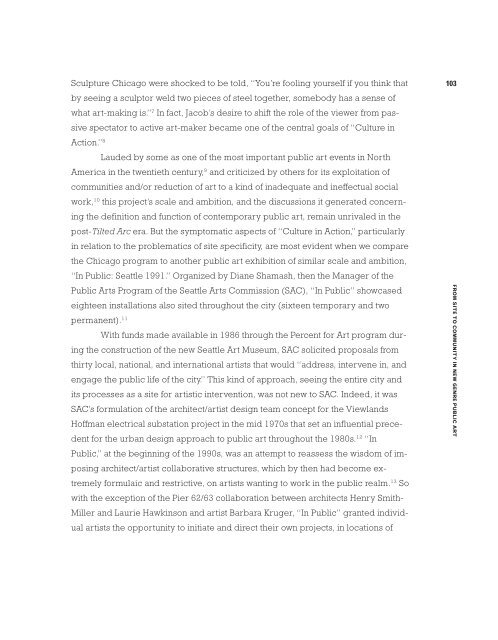ONE PLACE AFTER ANOTHER - Monoskop
ONE PLACE AFTER ANOTHER - Monoskop
ONE PLACE AFTER ANOTHER - Monoskop
Create successful ePaper yourself
Turn your PDF publications into a flip-book with our unique Google optimized e-Paper software.
Sculpture Chicago were shocked to be told, “You’re fooling yourself if you think that<br />
by seeing a sculptor weld two pieces of steel together, somebody has a sense of<br />
what art-making is.” 7 In fact, Jacob’s desire to shift the role of the viewer from passive<br />
spectator to active art-maker became one of the central goals of “Culture in<br />
Action.” 8<br />
Lauded by some as one of the most important public art events in North<br />
America in the twentieth century, 9 and criticized by others for its exploitation of<br />
communities and/or reduction of art to a kind of inadequate and ineffectual social<br />
work, 10 this project’s scale and ambition, and the discussions it generated concerning<br />
the definition and function of contemporary public art, remain unrivaled in the<br />
post-Tilted Arc era. But the symptomatic aspects of “Culture in Action,” particularly<br />
in relation to the problematics of site specificity, are most evident when we compare<br />
the Chicago program to another public art exhibition of similar scale and ambition,<br />
“In Public: Seattle 1991.” Organized by Diane Shamash, then the Manager of the<br />
Public Arts Program of the Seattle Arts Commission (SAC), “In Public” showcased<br />
eighteen installations also sited throughout the city (sixteen temporary and two<br />
permanent). 11<br />
With funds made available in 1986 through the Percent for Art program during<br />
the construction of the new Seattle Art Museum, SAC solicited proposals from<br />
thirty local, national, and international artists that would “address, intervene in, and<br />
engage the public life of the city.” This kind of approach, seeing the entire city and<br />
its processes as a site for artistic intervention, was not new to SAC. Indeed, it was<br />
SAC’s formulation of the architect/artist design team concept for the Viewlands<br />
Hoffman electrical substation project in the mid 1970s that set an influential precedent<br />
for the urban design approach to public art throughout the 1980s. 12 “In<br />
Public,” at the beginning of the 1990s, was an attempt to reassess the wisdom of imposing<br />
architect/artist collaborative structures, which by then had become extremely<br />
formulaic and restrictive, on artists wanting to work in the public realm. 13 So<br />
with the exception of the Pier 62/63 collaboration between architects Henry Smith-<br />
Miller and Laurie Hawkinson and artist Barbara Kruger, “In Public” granted individual<br />
artists the opportunity to initiate and direct their own projects, in locations of<br />
103<br />
FROM SITE TO COMMUNITY IN NEW GENRE PUBLIC ART

















